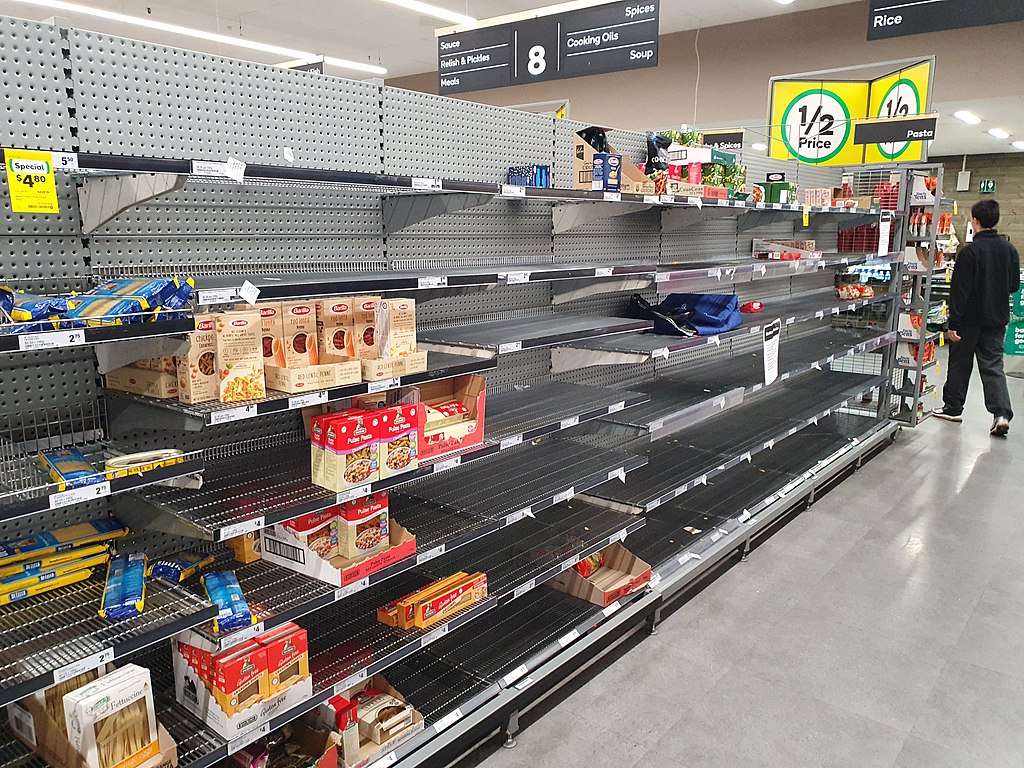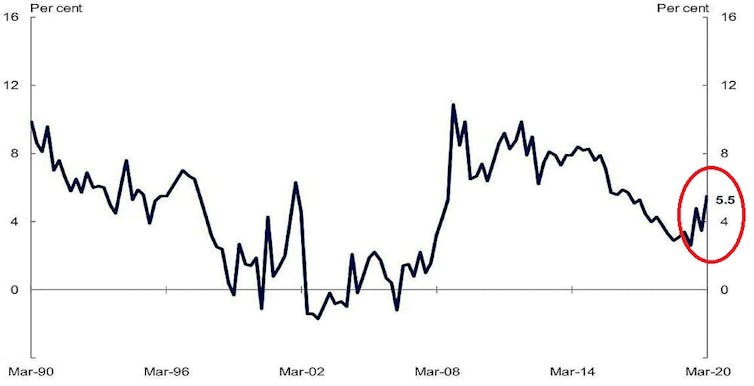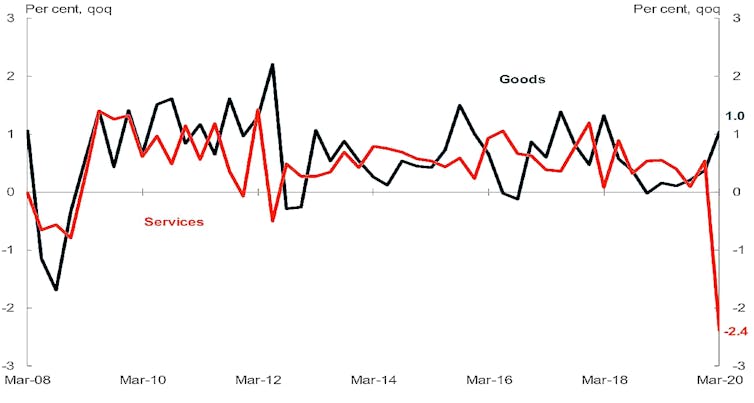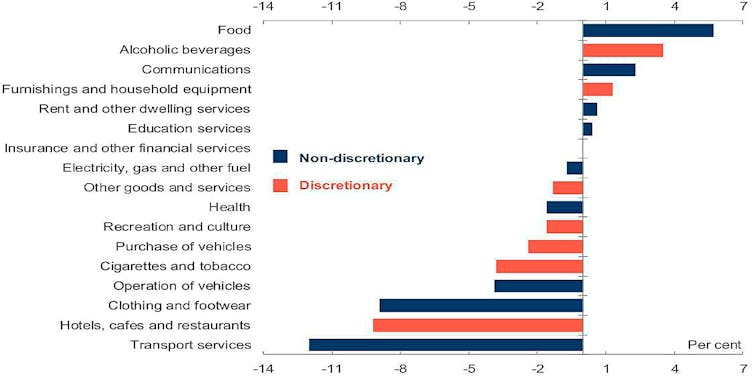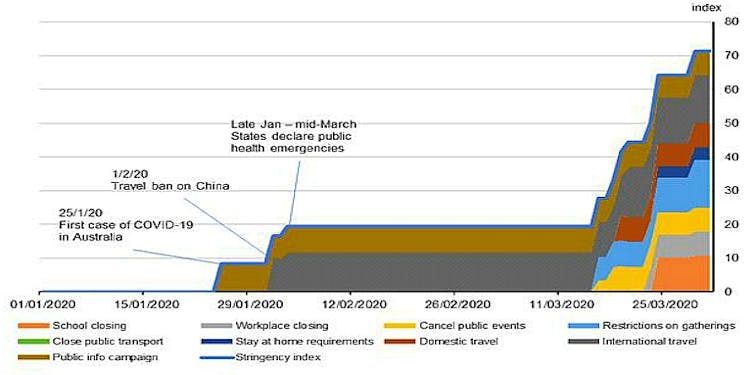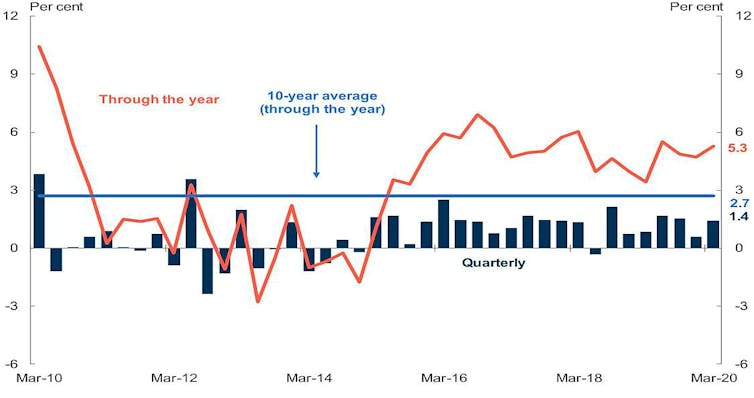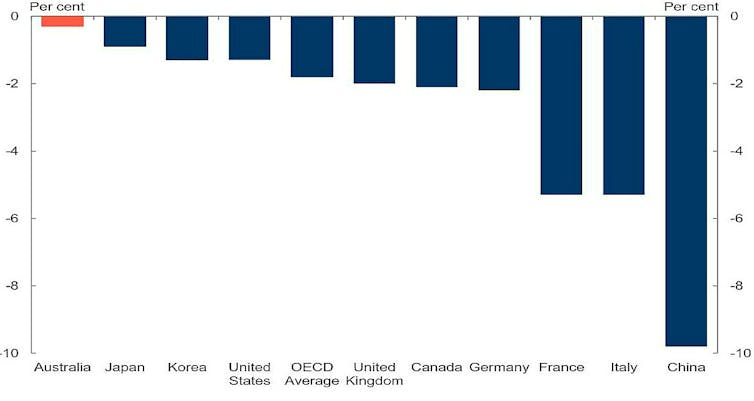A go-slow on spending sent the economy backwards 0.3% in the first three months of this year, only the fourth such decline since Australia was last in recession in the early 1990s.
Treasurer Josh Frydenberg says treasury has told him that the next three months, the June quarter that we are in at present, will see a “far more severe” contraction, one private sector forecasters believe could be as high as 10%.
Asked whether that meant Australia was already in recession, he said it did.
Quarterly GDP growth since 1990
Most unusually for an economic downturn, household incomes rose throughout the quarter, pushed higher by a 6.2% increase in government payments related to COVID-19 and the bushfires, and an 11.1% increase in insurance payouts as a result of bushfires and hailstorms.
But rather than spend most of it, Australian households dramatically increased saving in the quarter, pushing the household saving ratio up from 3.5% to 5.5% and pushing down household spending 0.2%.
Household savings ratio
Commonwealth Treasury
Spending on goods actually increased over the three months as Australians stocked up on essentials including toilet paper in March.
The production of “petroleum, coal, chemical and rubber products” surged 8.1% as consumers stocked up on cleaning and disinfectant products.
But spending on services plummeted, led down by dramatic falls in spending on transport and hotels, cafes and restaurants.
Household consumption, March quarter
Commonwealth Treasury
Spending on transport services (airlines and the like) fell 12.0%. Spending on hotels, cafes and restaurants fell 9.2%, each the biggest fall on record.
“Production” in these industries fell 4.9% and 7.5%. Profits fell 6.8% and 14.2%.
Spending fell on ten of the 17 consumption categories.
Household consumption by category, March quarter
Commonwealth Treasury
Most of the changes took place at the very end of the March quarter.
A new index of the “stringency” of COVID-19 containment measures released with the national accounts shows they ramped up only in the final two weeks.
Most have been in place for the entirety of the June quarter to date, suggesting the impacts on spending and production will be a “lot more substantial”, in the words the treasurer used in the national accounts press conference.
ABS stringency of containment measures index
Were it not for government spending, which has climbed 6.2% throughout the year, the plunge in March quarter GDP would have been much more severe.
Calculations of the Bureau of Statistics suggest it would have been twice as severe, a March quarter decline of 0.6% rather than 0.3%.
General government expenditure
Commonwealth Treasury
The treasurer described Australia as “on the edge of the cliff” in the March quarter, facing “an economist’s version of Armageddon”.
The treasury had been contemplating a fall in gross domestic product of 20% in the June quarter. Australia has avoided that fate by acting on health and the economy early.
Its fall in GDP of 0.3% in the March quarter was one third the OECD average.
International comparisons, real GDP growth, March quarter
Commonwealth Treasury
The treasurer has scheduled an economic update, which will include the result of a review of the JobKeeper program.
Asked whether it could be referred to as a mini-budget, he said it could be.
Peter Martin ne travaille pas, ne conseille pas, ne possède pas de parts, ne reçoit pas de fonds d'une organisation qui pourrait tirer profit de cet article, et n'a déclaré aucune autre affiliation que son poste universitaire.



 Germany’s Economic Recovery Slows as Trade Tensions and Rising Costs Weigh on Growth
Germany’s Economic Recovery Slows as Trade Tensions and Rising Costs Weigh on Growth  Australia’s Economic Growth Slows in Q3 Despite Strong Investment Activity
Australia’s Economic Growth Slows in Q3 Despite Strong Investment Activity  Europe Confronts Rising Competitive Pressure as China Accelerates Export-Led Growth
Europe Confronts Rising Competitive Pressure as China Accelerates Export-Led Growth  BOJ Faces Pressure for Clarity, but Neutral Rate Estimates Likely to Stay Vague
BOJ Faces Pressure for Clarity, but Neutral Rate Estimates Likely to Stay Vague  Asian Markets Stabilize as Wall Street Rebounds and Rate Concerns Ease
Asian Markets Stabilize as Wall Street Rebounds and Rate Concerns Ease  Asian Markets Mixed as Fed Rate Cut Bets Grow and Japan’s Nikkei Leads Gains
Asian Markets Mixed as Fed Rate Cut Bets Grow and Japan’s Nikkei Leads Gains  Dollar Slides to Five-Week Low as Asian Stocks Struggle and Markets Bet on Fed Rate Cut
Dollar Slides to Five-Week Low as Asian Stocks Struggle and Markets Bet on Fed Rate Cut  Oil Prices Rise as Ukraine Targets Russian Energy Infrastructure
Oil Prices Rise as Ukraine Targets Russian Energy Infrastructure  Asian Currencies Steady as Markets Await Fed Rate Decision; Indian Rupee Hits New Record Low
Asian Currencies Steady as Markets Await Fed Rate Decision; Indian Rupee Hits New Record Low  Asian Currencies Edge Higher as Markets Look to Fed Rate Cut; Rupee Steadies Near Record Lows
Asian Currencies Edge Higher as Markets Look to Fed Rate Cut; Rupee Steadies Near Record Lows  Asian Currencies Steady as Rupee Hits Record Low Amid Fed Rate Cut Bets
Asian Currencies Steady as Rupee Hits Record Low Amid Fed Rate Cut Bets  Dollar Holds Steady as Markets Shift Focus to 2026 Rate Cut Expectations
Dollar Holds Steady as Markets Shift Focus to 2026 Rate Cut Expectations  Asian Markets Mixed as RBI Cuts Rates and BOJ Signals Possible Hike
Asian Markets Mixed as RBI Cuts Rates and BOJ Signals Possible Hike  Japan’s Service Sector Sustains Growth Momentum in November
Japan’s Service Sector Sustains Growth Momentum in November  Oil Prices Hold Steady as Ukraine Tensions and Fed Cut Expectations Support Market
Oil Prices Hold Steady as Ukraine Tensions and Fed Cut Expectations Support Market  China’s Services Sector Posts Slowest Growth in Five Months as Demand Softens
China’s Services Sector Posts Slowest Growth in Five Months as Demand Softens  Trump and Lula Discuss Trade, Sanctions, and Security in “Productive” Phone Call
Trump and Lula Discuss Trade, Sanctions, and Security in “Productive” Phone Call 










